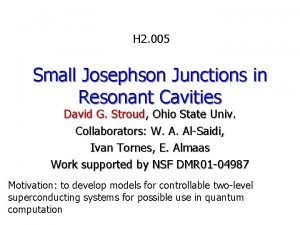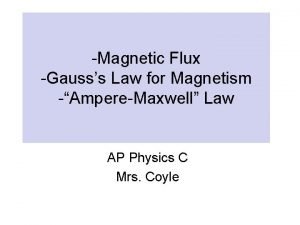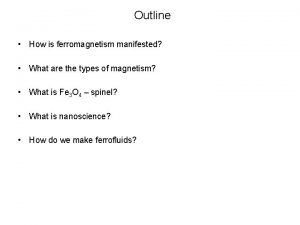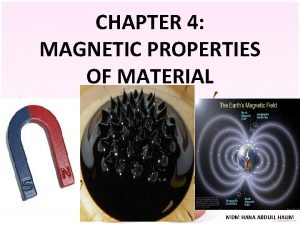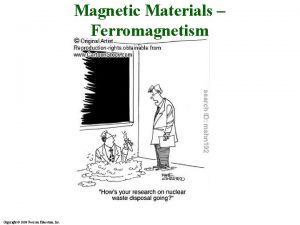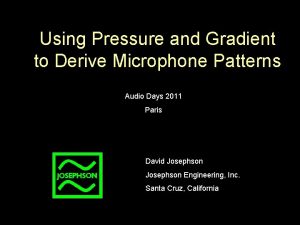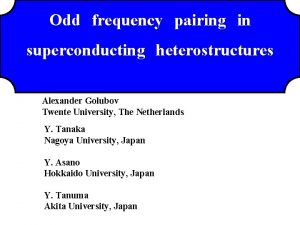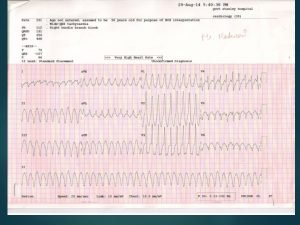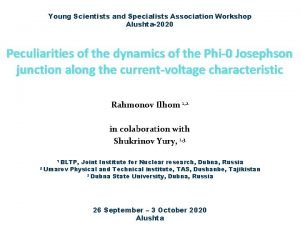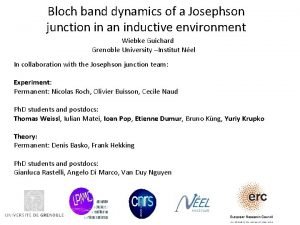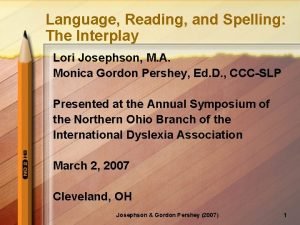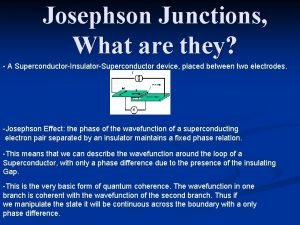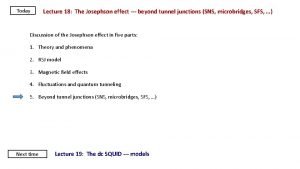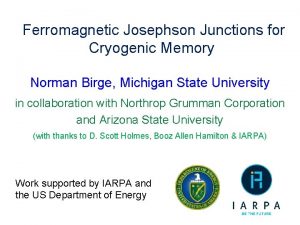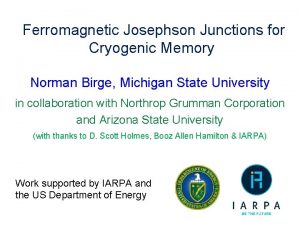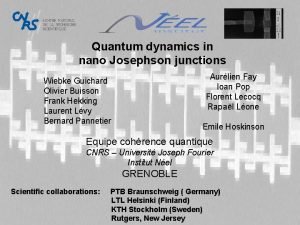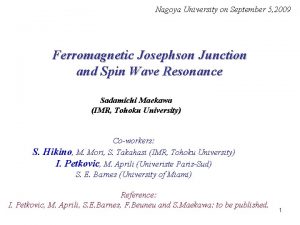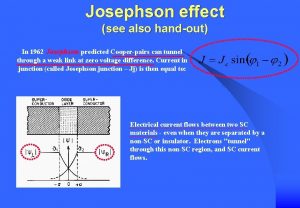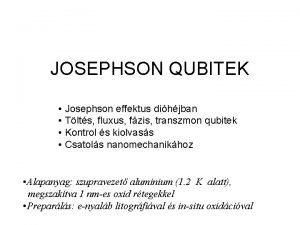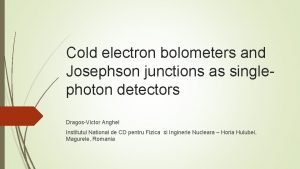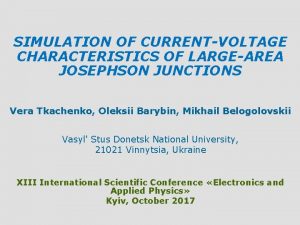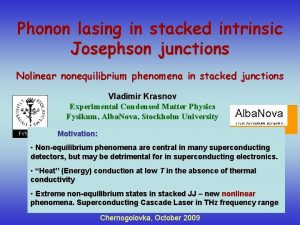Phase Dynamics of the Ferromagnetic Josephson Junctions I















- Slides: 15

Phase Dynamics of the Ferromagnetic Josephson Junctions I. Petković and M. Aprili Laboratoire de Physique des Solides In collaboration with: François Beuneu, LSI Hervé Hurdequint, LPS Sadamichi Maekawa, Tohoku University Stewart Barnes, University of Miami GDR Physique Mesoscopique, Decembre 8 -11 2008, Aussois.

Spin Physics in Superconductors Y = Y 0 ei How couples to the spin degrees of freedom ? S: SF: -k. F +dk. F Cooper pair = 2 dk x = Spin splitting - FFLO Fulde Ferrell Larkin Ovchinnikov 2 е = ћ Aharonov-Bohm phase in hybrid structures: S F (t) Magnetic Flux Eex x ћ v. F ∫A·dl M(t) S 1. 2. Required small junctions 2. Adiabatic phase transformation

Junction Fabrication Nb 3 Pd. Ni 2 1 mm 2 mm Si 3 N 4 PES 1 Nb SEM photo of the mask cross section: 500 nm SIFS SEM photos 500 x 500 nm T=1. 2 K Nb(50 nm) IJ T=5. 7 K Nb(50 nm) Pd. Ni(20 nm) Nb. O IV curve

Magnetostatics and the Josephson phase Analogy with Fraunhofer diffraction = o - 2 p o ∫A·dl sin (p / o) = (p / o) Ic (0) Ic ( ) 2 p = B·S = o A A B B C I=Icsin C time-reversal t -t B -B We measure a shift in the Fraunhofer pattern due to magnetization.

Magnetization Dynamics and the Josephson effect d dt = 2 e ћ (t) = o - VDC = w. J Josephson frequnency I V I= VDC R + IC 2 2 V w. J ≈ w. S 10 m. V ~ 5 GHz R – k IC 2 c’’(w. J) susceptibility of the ferromagnet equivalent circuit : JJ X R ∫A(t)·dl M(t) spin wave resonance w. S VDC Resonant coupling 2 p o Z(w) ~ c’’(ws)

Josephson spectroscopy of the magnetic modes mm trilayer same cross-section non-ferro Josephson FMR: Resonant cavity 9. 3 GHz ws = g (Hk – 4 p. Ms)2 – H 2 Hk anisotropy field Ms saturation magnetization 900 G ws= w. J ~ VDC = 23 m. V no fitting parameters !

Coupling with external RF – Shapiro step side bands Vac d dt cos(Wt) = 2 e ћ resonances : VDC + Vac(Wt) 2 e ћ VDC = w. J = n. W n-integer Shapiro steps VDC -50 d. Bm 20 d. Bm with ferromagnetic modes: W 2 W sideband resonances at W-ws w. J = n. W ws

Phase Dynamics Is there a contribution of magnetization dynamics to the phase noise? I JJ X R C P(I) Current-biased Josephson junction IS Ir + b + w 02 sin = hb sin wbt damping RC plasma freq. Pump probe measurement 350 m. K 37 Hz ramp Ib pump V probe Dt<t SIFS phase relaxation time

Phase Dynamics in the Stationary Regime slow ramp Kramers escape k. BT 4. 2 K 0. 5 K 0. 8 K 1. 1 K 3 K 2 K Effective temperature equal to bath temperature. No additional temperature due to ferromagnet.

Non-stationary regime - Bifurcation fast ramp freq. wb wb<<t Kinetic Phase Transition wb≈t ts tr wb>>t P(I) Bifurcation timescale is damping time, due to KPT. Ir Is I

Phase Relaxation Time - tj Ir Is N 1 – number of events at Ir T=350 m. K nb=4 k. Hz nb=6 k. Hz ramp freq. wb=2 pnr nb=12 k. Hz N 1=1 - A exp (- t wb ) direct measurement of the phase relaxation time T=350 m. K t ~ 50 ms

Numerical Simulations numerically fitted formula hb wb N 1=1 – 1. 8 exp (- 0. 76 3/2 ) b -1 b=(Rqp. C w 0) range of parameters: b, wb = 0. 0001 - 0. 1 w 0 T=1. 5 K n* - frequency at which bifurcation starts T=0. 67 K The phase relaxation is set by the quasiparticle resistance.

Electromagnetic waves inside the ferromagnetic barrier – Fiske steps Fiske step – resonance between em cavity mode and Josephson phase. I non-ferro (x) due to B Insulator L B wn = ferro kn = n p/L 2 e Vn = c k h FERRO first NON-FERRO second Offset in dispersion relation due to ferromagnet.

Fiske resonances and bifurcation To augment sensitivity in bifurcation measurement, we trigger at the Fiske resonance, not Ir bifurcation DC measurement

Conclusions Time reversal symmetry of Josephson coupling. Diffraction pattern with “wedge phase plate” : Fraunhofer pattern with finite Magnetization Spectroscopy of Ferromagnetic modes Nano. FMR (105 Ni atoms ) High sensitivity to domain wall dynamics Kinetic phase transition allows to probe the phase relaxation time of strongly underdamped Josephson Junctions. Coupling to EM modes (Fiskes steps)
 Josephson junctions
Josephson junctions Ferromagnetic substance example
Ferromagnetic substance example Ferromagnetism
Ferromagnetism Magnetic field strength h
Magnetic field strength h Hysteresis loop magnetism
Hysteresis loop magnetism What is ferromagnetic material
What is ferromagnetic material Josephson c700s
Josephson c700s Michael josephson ethics
Michael josephson ethics Alexander golubov
Alexander golubov Vereckei algorithm
Vereckei algorithm Josephson junction
Josephson junction Josephson effect
Josephson effect Marvin josephson
Marvin josephson Josephson devices
Josephson devices Josephson junction
Josephson junction Josephson institute of ethics
Josephson institute of ethics
